Basketball diaries: The illusion of control
The Mavs were inches away from taking a 3-0 lead in the 2006 Finals. They believe they were screwed out of a title. But that's not how life works.
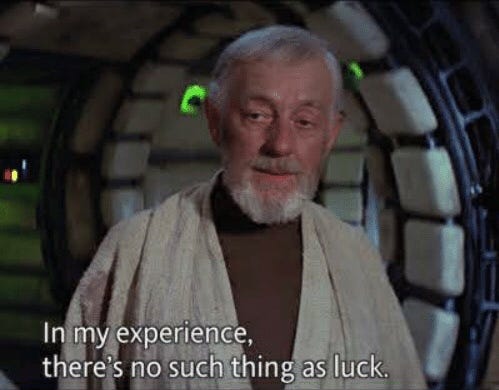
Don’t think like Obi-Wan. It’s unhealthy.
I rarely buy books right when they come out in hard cover, but I made an exception for The Biggest Bluff, Maria Konnikova’s fascinating journey from total poker novice into a successful pro. The book pairs two of my pet interests outside of basketball: social psychology and poker. (The latter had waned since my early 20s because I feared that I’d become obsessed and lose too much money if I really pushed on. Turns out my risk tolerance isn’t very high).
Konnikova has quickly become my favorite non-fiction writer. Her book on con artists indirectly explains Donald Trump’s appeal, and her Sherlock Holmes deep dive is full of practical insights even if you never read Arthur Conan Doyle. (I strongly recommend listening to her recent appearance on the True Hoop podcast). Here’s how she described poker’s appeal:
“Poker has a mathematical foundation, but with a dose of human intention, interaction, psychology — nuance, deception, little tricks that don’t quite reflect reality but help you gain an edge over others. Humans aren’t rational. Information isn’t open to all. There are no “rules” of behavior, only norms and suggestions — and within certain broad constraints, anyone might break those norms at any point.”
Because of all that, poker mirrors real life. As Konnikova writes: “No amount of formal modeling will ever be able to capture the vagaries and surprises of human nature.” As in life, training in poker gives you an edge, not the answer. Erik Seidel, Konnikova’s poker mentor and one of the greatest players of all time, compares poker to playing in a jazz band. “It’s all about what are these guys doing, and how do I respond to it?” he tells her. “To the best extent that you can, you have to be a freethinker.”
You know what else is commonly compared to jazz (and not just by Michael Scott)? Basketball. Especially pro basketball.
The NBA is a league of incredible skill, athleticism, and intelligence. It’s also one where players regularly do everything right and still miss the shot. A team can play perfect defense and fall victim to someone making a seemingly impossible bucket. Pro basketball is easy to follow, but hard to understand. It’s a continuous game of rapidly changing information and adaptive decision-making — an individual sport shaped by an overall team structure. Just like poker, but without the jumping.
Konnikova ultimately becomes a successful poker pro by accepting that while she cannot control the cards, she can control her own decisions. She learns to accept that it’s possible to play a hand perfectly and still lose. That frees her to focus on making the best decisions possible and letting the chips fall where they may, so to speak. Those that fail to grasp that wisdom compound their bad fortune with victimhood and poor decisions in the future.
That brings me to today’s game diary: Game 3 of the 2006 NBA Finals between the Dallas Mavericks and Miami Heat. This was a game and series where fate intervened. One team made the most of the cards they were dealt. The other fumed about the control they believe they unfairly lost.
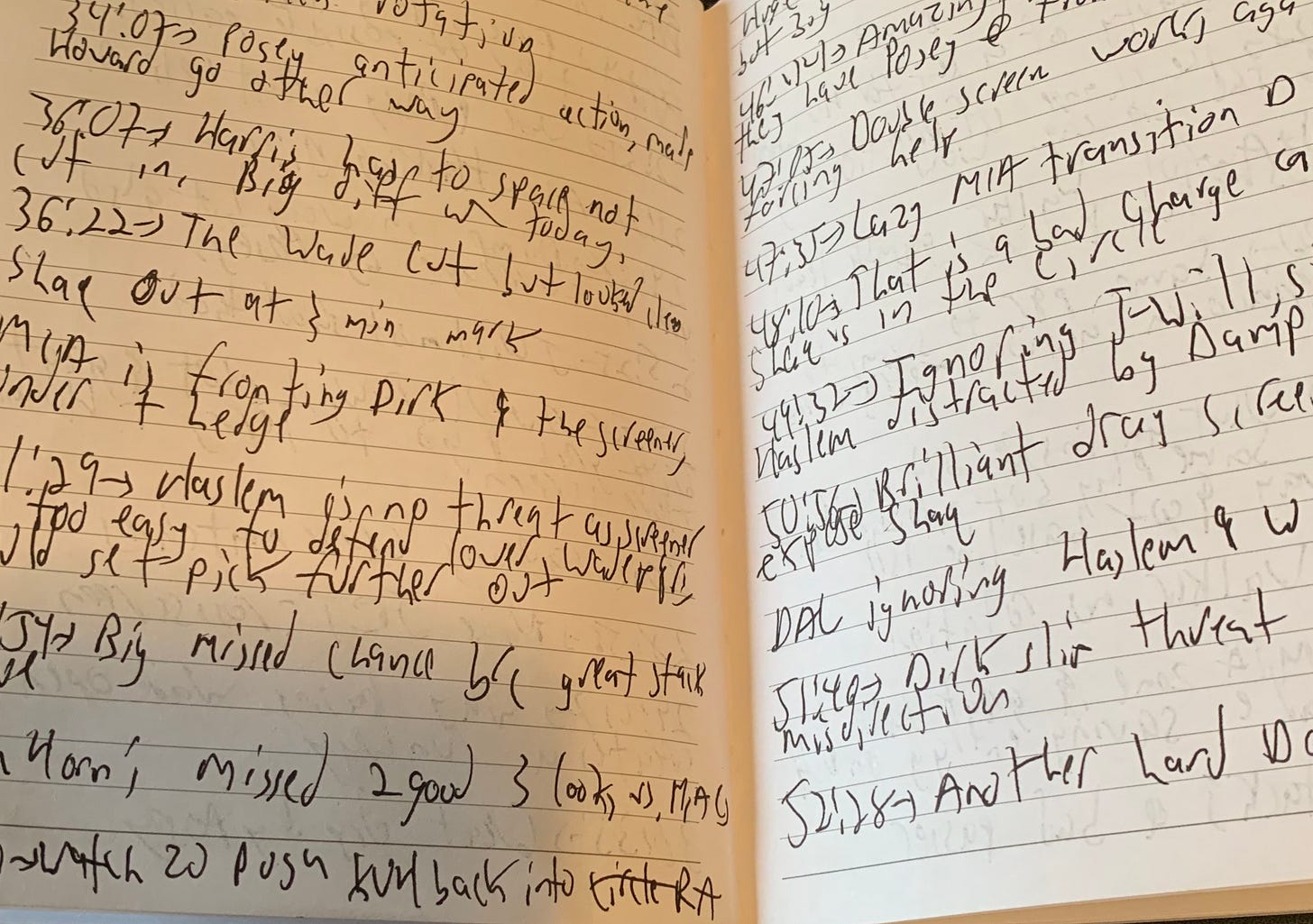
The Mavericks won the first two games in Dallas and took a double-digit lead late in the fourth quarter of Game 3. The series looked to be theirs. Instead, they fell apart down the stretch, lost the game when 90-percent free-throw shooter Dirk Nowitzki missed a game-tying attempt, and ultimately lost the series as Dwyane Wade paraded to the free-throw line.
Ten years later, Mavericks owner Mark Cuban still believed his team was screwed out of a title. (He considered filing a lawsuit and even consulted with a former FBI investigator). The outcome was determined by outside forces, therefore it must be invalid. But as Konnikova and the game of poker teach us, we can never control fate entirely. We can only control how we respond to it.
The goal of this diary isn’t to adjudicate bad officiating or take pity on the Mavericks seeing a sure title slip through their fingers. It’s an exercise to understand what threw the Mavericks off kilter, how they ultimately collapsed, and why they still don’t see it that way.
Here’s the full game. Just like last time, time codes refer to the YouTube video, not the game itself.
Jason Terry, Adrian Griffin, Josh Howard, Dirk Nowitzki and DeSagana Diop start for Dallas. Miami counters with Jason Williams, Dwyane Wade, Antoine Walker, Udonis Haslem, and Shaquille O’Neal.
FIRST QUARTER
0:54 to 6:29 — The Mavericks struggle out of the gate offensively because their starting lineup doesn’t have enough perimeter shooting. Wade is able to roam off Griffin to help on the back line when Shaq is forced to trap pick-and-roll. The Heat also have Walker taking an extra step off Howard, further compressing the floor.

Dallas is starting Griffin to guard Wade, but the Heat spend most of their time going to Shaq early on. That’s why Avery Johnson quickly calls timeout to put Jerry Stackhouse in the game. His presence will open up the Mavericks’ pick-and-roll game and expose Miami’s many individual defensive liabilities.
8:20 — You see the domino effect of inserting Stackhouse right away. Wade’s a terrific help defender, but his man-to-man defense isn’t nearly as strong. He allows Stackhouse to go baseline, away from Shaq’s trap. Williams is forced to help, Haslem must help the helper, and Dirk is wide open for three.
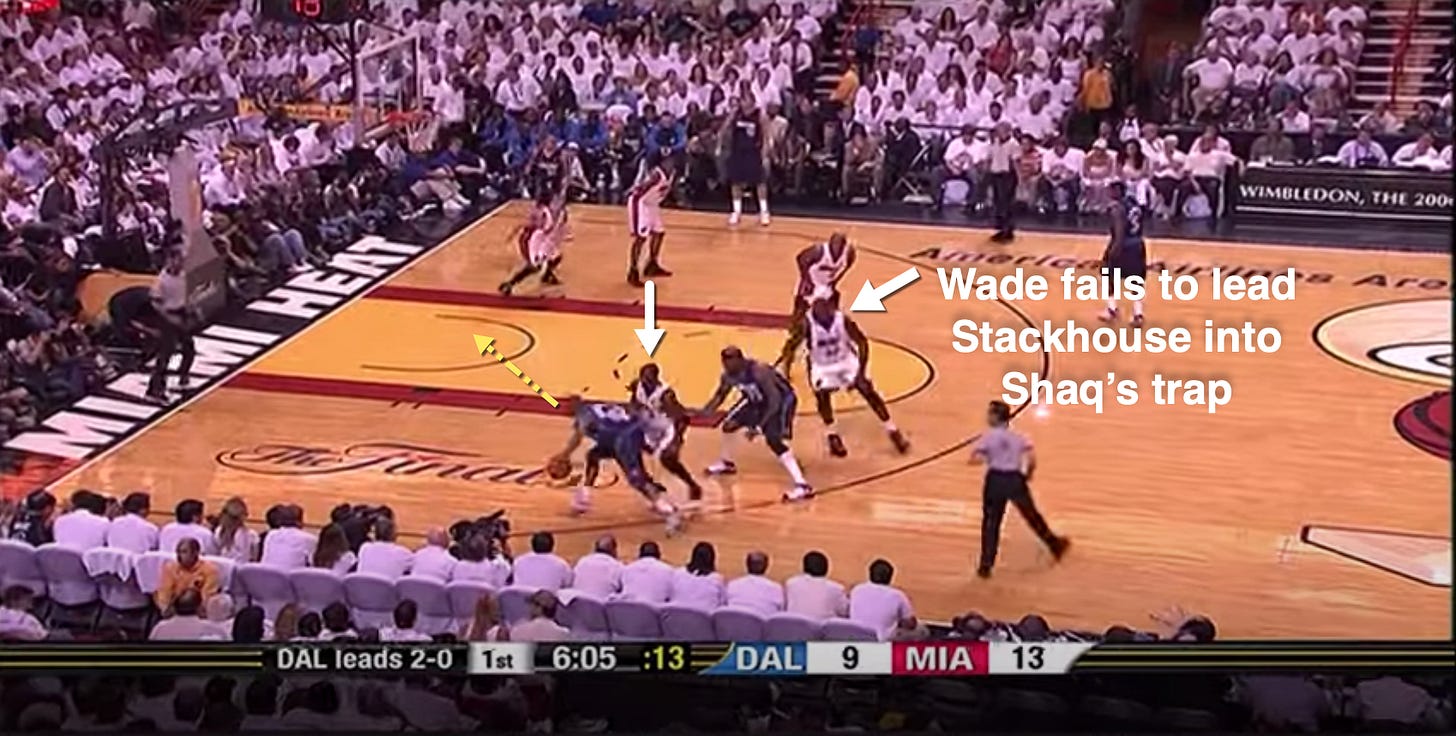

Hubie Brown admonishes Stackhouse for passing up a layup, though I doubt he’d say that if Dirk hit the three. The more important point is that Dallas executed to perfection, but didn’t get the payoff.
15:50 — Here’s another possession where Dallas stretched Miami thin and just couldn’t convert. The Mavs run a pick-and-roll targeting Miami’s two worst defenders in space: Walker and Shaq. They know Shaq is going to trap, so Stackhouse baits him out as Erick Dampier (in for Diop) slips off Walker. Haslem can’t stray too far off Keith Van Horn (in for Dirk), so Wade must decide to help on Dampier’s roll or stay with the sharp-shooting Terry on the perimeter.
Today, pick-and-roll ball handlers must deliver this read effectively. They have to freeze Wade with their eyes, making him think they’re going one way before passing the other. Stackhouse … could not do that.

And yet, Dallas still gets an open three that clanks off the rim. Great set, no result.
16:18 — Harris gets to the rim and blows the drop-off pass to Dampier. The Heat score on the other end. Four-point swing.
19:34 — Mavericks fans believe Dwyane Wade benefitted from a friendly whistle all series, but I didn’t really see it in this game. The real reason Wade got to the line so much was that he had the flexibility to change directions so sharply and the core strength to power through glancing contact when he did. The efficiency of movement on this Eurostep is devastating.

When we complain about fouls, we fail to appreciate the athleticism required to go from this position.

To this position in just two steps.

Wade has beaten Harris to the spot, albeit barely and at an angle that’s impossible for someone without his flexibility and strength. He creates natural body contact, which is a foul.
Nowadays, flexibility and stability training are key elements of every NBA player’s workout regiment. Today’s perimeter defenders can more easily stay upright while sliding their feet, which stops the Wades of the world from getting the proper angle to draw a foul. In 2006, Wade’s economy of movement was far ahead of Dallas’ defenders — and anyone else’s. The fouls looked ticky-tacky, but they were (mostly) real fouls that only happened because of Wade’s ability to change direction so sharply.
SECOND QUARTER
27:47: Dallas has switched to a matchup zone, and not just to get more stops. The other purpose is to create matchup confusion and further take advantage of Miami’s leaky transition defense.
Griffin snags a long rebound over Walker and immediately turns up court to create a 4 on 3 situation. At this point, Miami’s matchups are already screwy. Walker’s man is Josh Howard, except Howard was at the top of the zone contesting and then leaking out on Williams’ three. It takes a split second for Williams and Gary Payton to decide who covers for Walker. By the time that happens, Griffin is in the frontcourt and Howard is setting a flare screen on Payton to open up this Terry three.

Dallas’ zone is the vehicle causing the tiny bit of hesitation that ended with Payton stuck on the wrong side of Howard.
31:33 — Here’s another example of Wade’s core strength creating what looks like a ticky-tack foul, but a foul nonetheless. Though it shouldn’t seem possible, Wade catches the ball on the run and beat Griffin to a very tight angle.

Griffin tries to cut him off with one large step, but Wade gets so low that he’s able to continue on his path and open up Griffin’s chest. That’s when Griffin’s arm comes down and slaps Wade across the shoulder, a clear foul.
I understand Griffin’s frustration. His last step is enough to cut off the angle against almost any other player. Few can get low like Wade and continue on their path to the basket. But Wade can, so what counts as great defense against most players is a foul against him. None of that is the referee’s fault.
33:54 — Here’s a great play by James Posey that’s tough to spot unless you’re looking for it. The first option on Dallas’ after-timeout play is for Howard to curl off a double screen and attack downhill coming toward the middle. He can then surge to the rim or leverage the combined threat of Dirk popping and Diop rolling into an open shot for someone.
But Posey saw all of that developing before it happened. He positions himself to overplay the initial cut, forcing Howard to come inside the double screen instead of looping around it.


The Mavericks get Howard an open shot curling back to the left wing, but it’s not their first option. There’s no stat for “forcing opponent into the less ideal scenario on an out of bounds play,” but that’s exactly what Posey did.
41:54 — The Mavericks lost this game by two points, so you could argue this missed dunk was the difference in the game.
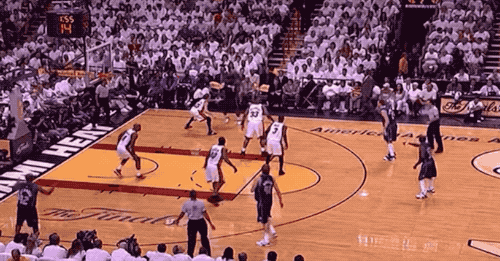
THIRD QUARTER
49:28 — Determined to avoid a repeat of the first quarter, the Mavericks ignore Williams and other perimeter players to swarm to Shaq. Terry’s tap dance routine on the opposite side induces a tough pass inside instead of the more obvious swing to Williams. Dampier then outruns Shaq up the floor and draws Haslem’s attention, opening Dirk up for three.
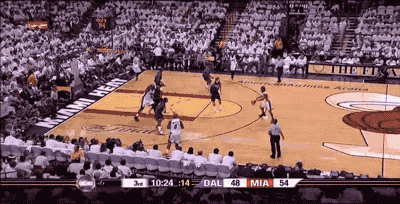
56:20 — Dallas’ pick-and-roll game is rolling now, so it’s time to layer other cool stuff on top of it. This set begins with Terry and another screener on the left side, with a third man (usually Stackhouse) positioned beyond the three-point line on the right wing. The goal is to get Miami to trap the pick-and-roll, slip the screener into open space, and immediately pass to the opposite wing to initiate the actual play they want.

In this case, Dallas forces Walker out, then spins him around again by running Howard off a Terry screen. Nifty.
1:01:33 — Same play, except this time Howard slides along a double screen on the baseline and gets the whole side cleared out to attack Walker one-on-one. “No way, no way can Walker guard him,” proclaims Brown. He’s right, but he’s also stating something obvious to both teams already. The Mavericks want to create that situation; the Heat want to prevent it.
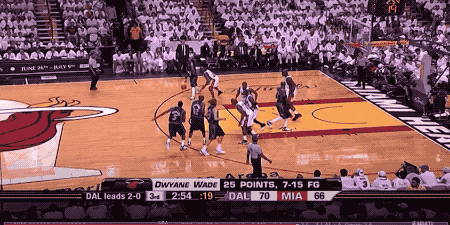
The reason Dallas wins this battle is that they exposed Walker for lunging too hard a few plays earlier. Not wanting to get beat twice the same way, Walker retreats more cautiously after hedging out on the pick-and-roll. The Mavericks were counting on that, so they send Howard through to the other side, leaving Walker caught way behind the play.
This is why you have to watch the whole game to know why certain plays succeed and others fail. The Mavericks set the first play up with their pick-and-roll proficiency, then used the memory of that first play to make the second one work. You can’t understand how one play worked without knowing the others that came before it.
FOURTH QUARTER
1:11:33 — When Wade doesn’t score, the Heat don’t score. Worse, their transition defense continues to be an abomination that compounds their offensive woes.

The floor balance is decent enough. Wade and Walker are back, Payton is in position to retreat, and Posey correctly hustles to account for Dirk. But Wade, who is surely fatigued from the offensive load he’s carried, is upright and unprepared for Harris to come at him. Payton should be offering support, but he lingered in the backcourt trying to stop an outlet to Howard for some reason.
One quick crossover is all Harris needs to leave Wade in the dust, draw Posey, and feed Dirk.
1:13:29 — Dallas is up 12 and Wade is on the bench. Big trouble. The Mavericks swarm Shaq again and dare Williams or Posey to beat them. Shaq kicks to Williams, expecting a re-post. Williams shoots immediately instead. Terrible decision. Exactly what Dallas wants.
The shot goes in.
1:16:30 — Up 11, Dallas squanders some beautiful ball movement when Stackhouse passes up a three to drive into traffic. Shaq slides over and takes the charge.
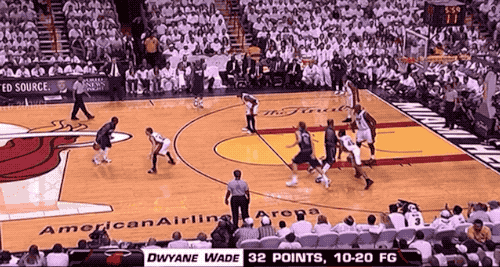
Today, you’d see Stackhouse sidestep Wade’s closeout and shoot a three. Purists may hate that move, but Stackhouse’s mistake illustrates why future players developed it.
1:17:05 — This looks like a soft whistle, but the Mavericks only have themselves to blame. Dampier leaves his help position way too early and Wade takes advantage by exploding in front of Howard. As he does, Howard’s arm slaps down on Wade’s shoulder.

It looks soft only because Howard lacks the upper-body strength to keep his arm extended as Wade drives through him. That’s a weakness only a few offensive players can exploit. Wade’s one who can.
1:18:03 — This is an important three by Posey, set up by an even more important cut along the three-point line.

Remember the Stackhouse charge a few plays before? Williams caught the ball in the same place and was about to crash into Dirk the same way Stackhouse slammed into Shaq. The difference is Dallas’ wings stood still and Posey manufactured his own luck with an instinctual cut.
1:21:00 — This replay angle reveals Wade’s incredible athletic skill. The first step to explode by a reaching Howard is just the beginning.

Look at Wade’s right leg. How is it still in one piece?
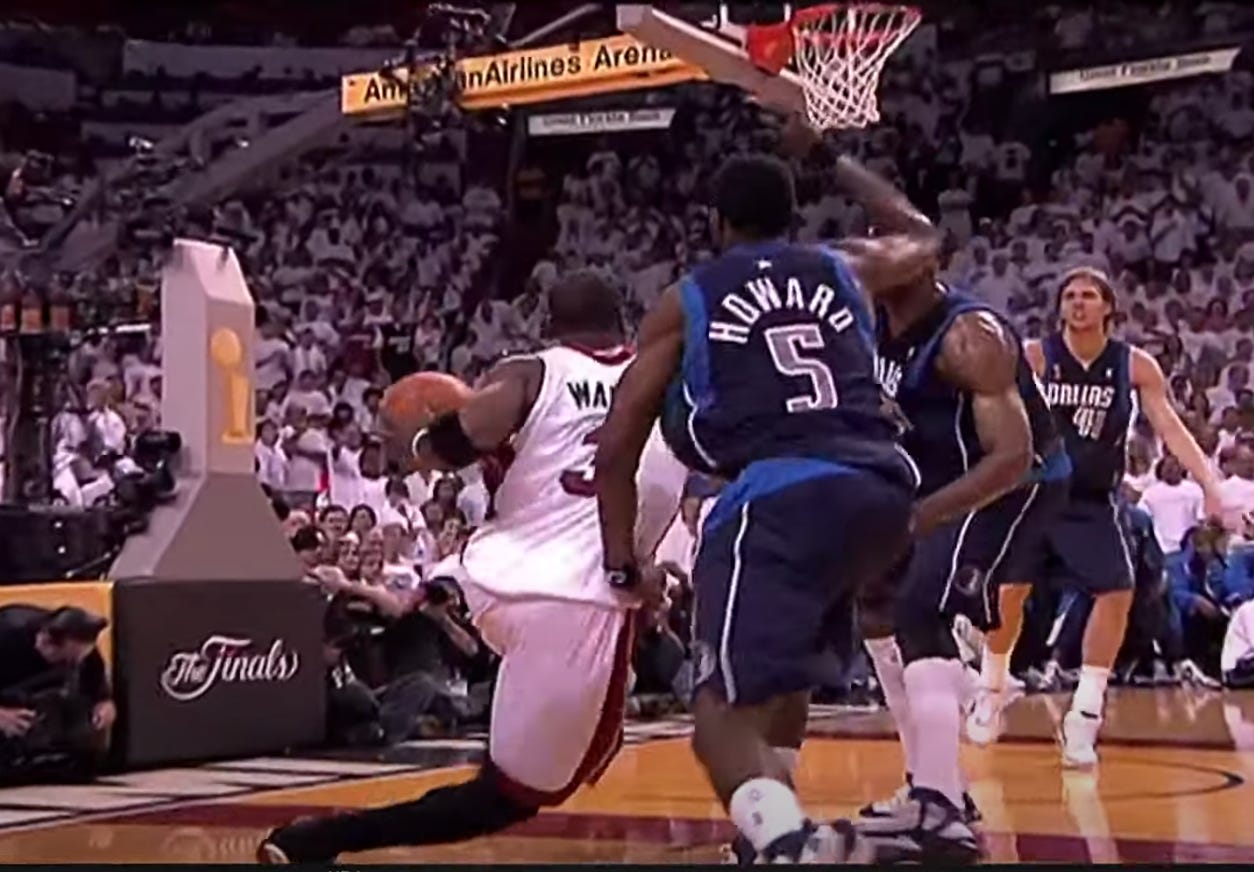
But the most amazing part is that Dampier has anticipated this move! He knows Wade’s tendency to zig zag, so he purposely doesn’t cut Wade off on the baseline. He knows Wade will explode through him and draw a foul if he over-commits. So he waits for Wade to come to him.
And then Wade somehow trumps that by jumping straight up off his left foot rather than sideways into him. Hubie marvels at Wade’s hang time, which is tremendous. But I’m more impressed that Wade had the leg strength and body control to jump straight after practically laying his other leg on the floor. How did he not skid right into Dampier’s waiting arms?
1:22:41 — As I mentioned in the last game blog, it’s a mistake to pass up a fast break when you’re ahead in the final few minutes. Howard wins the battle to a loose ball and somehow squirts it out to Terry before Haslem can force a tie-up. Dampier sprints ahead of Shaq, creating a 4-on-3 situation. A bucket would give Dallas a seven- or eight-point advantage with two minutes left.
Instead, Terry holds the ball up to kill clock. The Mavericks lollygag through a terrible possession and get called for a shot clock violation.
1:23:35 — Shaq gets away with a push-off on an offensive rebound and draws a foul. Bad fortune. Even worse fortune: Shaq actually sinks both free throws.
1:24:42 — Two huge plays by Haslem, who has not played well up to this point.
First, Dallas goes back to its bread-and-butter: a Terry/Dirk pick-and-roll on the right side. Haslem’s reluctance to leave Dirk has allowed Terry to turn the corner all game. But Haslem gets out this time, recovers with his hands up to prevent Dirk from slipping, then bumps Dirk off his re-screen angle. The Mavericks are forced to settle for a Stackhouse pull-up that misses.
Then, after Wade hits an open jumper to cut the Mavericks’ lead to one, Haslem sneaks around Dirk to get the steal. He makes both free throws after getting fouled on the breakaway, and the Heat somehow lead.
1:27:22 — Dallas calls timeout and goes back to the same Terry/Dirk two-man game on the right side of the floor. Remember, Dallas just watched the Heat trap the play for the first time all game. In response, Dirk makes a brilliant adjustment to stay back and pick off his own man rather than Terry’s, effectively turning Haslem into the screener.

That allows Terry to turn the corner and break down Miami’s defense. Mission accomplished! Except …
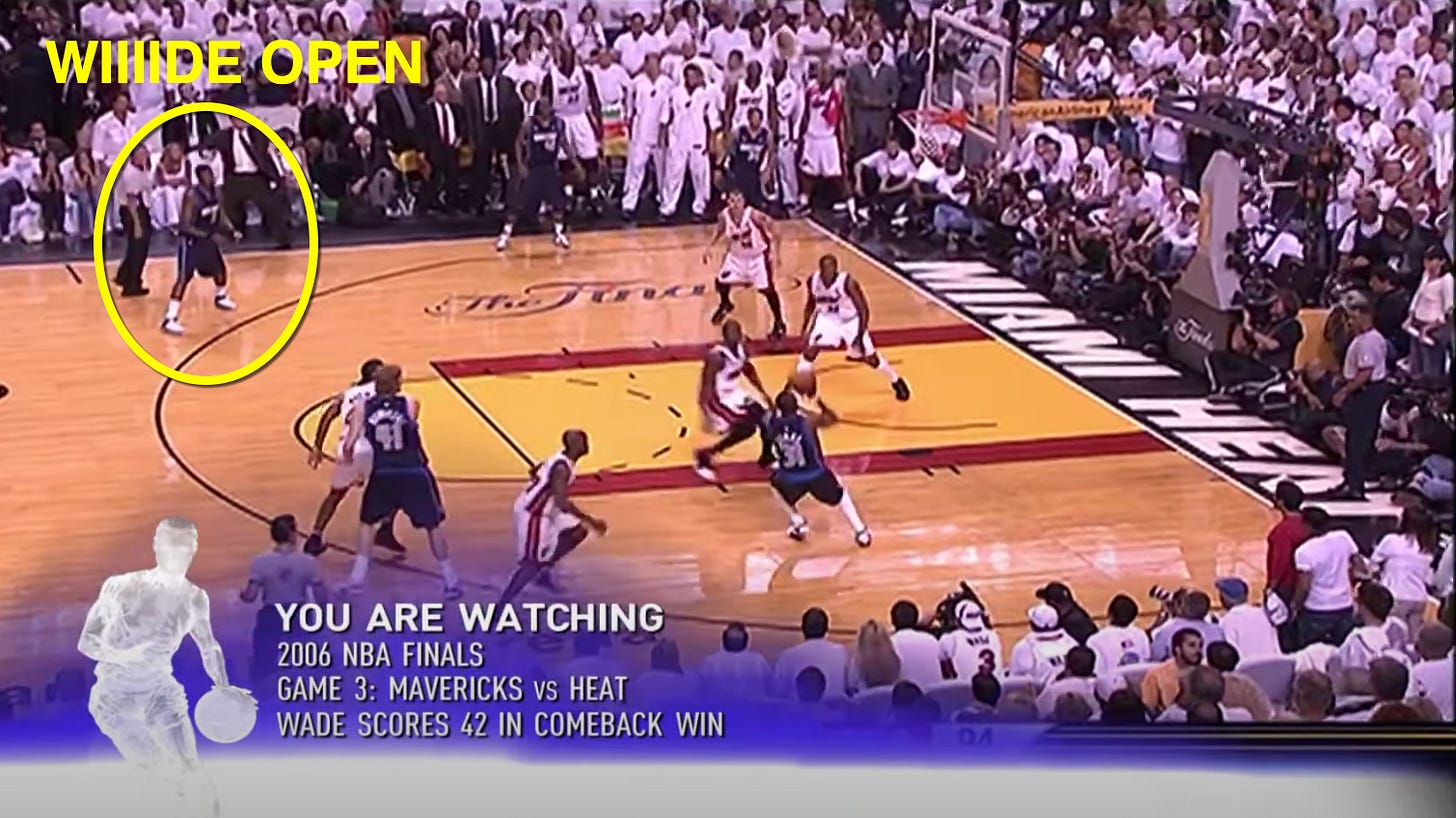
Terry shoots a contested pull-up jumper over Wade instead of swinging the ball to an open Howard. That's a selfish play. Posey hits one of two free throws to give Miami a two-point lead.
1:28:47 — On the ensuing possession, Dallas makes Dirk a decoy and runs a high pick-and-roll involving Harris and Howard. That is a bold call by Avery Johnson, but it’s also the right one. Wade’s lateral quickness on the ball has been shaky since midway through the third quarter and this play call exposes that. Harris freezes him and converts on the layup. Tie game.
Plus, Dallas got the two-for-one. Perfect execution.
1:29:00 — The ensuing Heat possession is a total mess. Wade burns time, then inexplicably picks up his dribble with eight seconds left. Payton ends up catching the ball at his shoelaces with three seconds left on the shock clock. Pump fake, one dribble, contested jumper. A prayer, really.
Swish. Miami leads. It’s Payton’s only shot of the game.
1:30:35 — Dallas dials up another incredible out of bounds play. Harris pops out to get the ball, while Terry, Howard, and Dirk set a series of screens for each other in the paint. Terry levels Haslem with a backscreen, and Miami can’t recover quickly enough to stop Dirk. Foul. Two free throws for a 90-percent shooter.
The first swishes as expected. Then, this happens.

I’m struck by Harris and Terry chilling in the backcourt instead of attacking the offensive glass. Dallas is down one point with three seconds left. Why not commit everyone you have to grab the offensive rebound? There’s no point in just standing there.
But Harris and Terry are human, and human brains aren’t wired to make probabilistic determinations in real time. Their image, our image, is of Dirk as an automatic bucket from the free throw line. But in reality, he’s a 90-percent free throw shooter, not an 100-percent one. There’s a 10 percent chance he misses, and 10 percent isn’t nothing.
Terry and Harris could have come in handy. Posey blows the box out on Stackhouse, but Wade comes flying in to save the day. He’s able to do that because he has no box out responsibilities himself, which might not have been the case had Dallas’ guards crashed from the perimeter. You just never know.
1:32:37 — Dallas gets one last chance with one second left after Wade splits the free throws. Miami leads by two.
The Mavericks design an amazing after-timeout play for the occasion. Four players come together at the elbow, and Terry sets a perfect back screen to free Howard up for the lob. (Terry was a hell of a screener).
Miami is switching every screen to stop this very action. But Howard is sprinting at full speed, and Wade is stuck on his tippey toes. A great passer sees that cue and immediately throw the lob to Howard.

Unfortunately, Dallas doesn’t have a great passer on the roster, leaving Dirk as its best option to throw the ball in. Dirk releases the ball a fraction of a second too late, giving Wade juuuuuuuusssssssstttt enough time to recover and make a spectacular game-saving play.

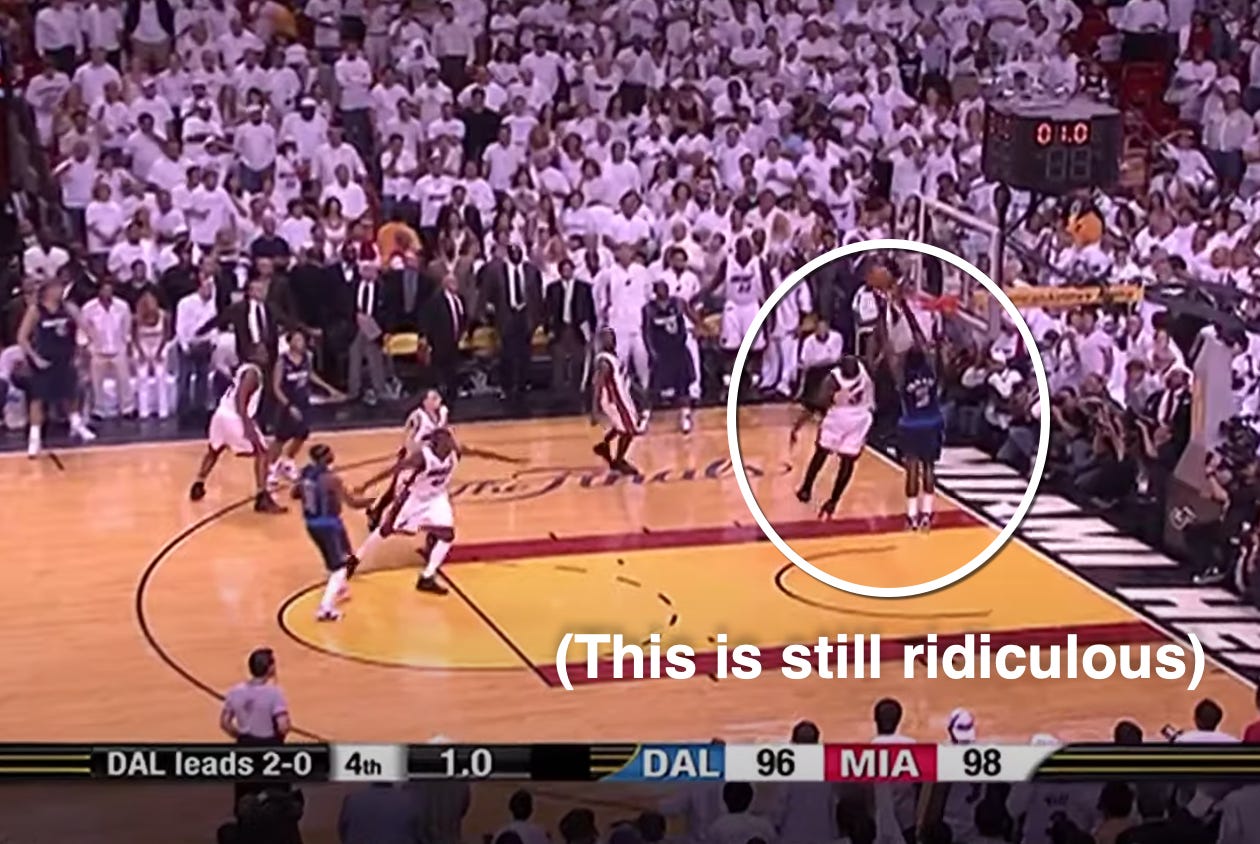
I understand why Mavericks fans go all Butterfly Effect on this series. There were so many moments that would have changed the outcome of this game. Many were beyond the Mavericks’ control. Others were inexplicable mistakes that rarely happen. All the Mavericks needed was for one to go different. One small thing can change everything.
But that’s no excuse to point fingers and blame every bad outcome on the cosmic forces conspiring against you. The Mavericks had chances to change the result of the game and series and didn’t take them. If they think Miami’s title was unearned, then every title is unearned. Every champion gets lucky.
That’s just how fate works. It’s not fair, but is also plays no favorites. Basketball, like poker, is a great avenue to teach that vital life lesson.



